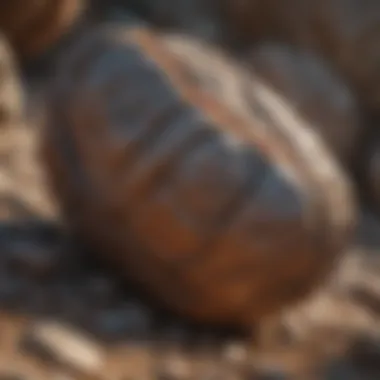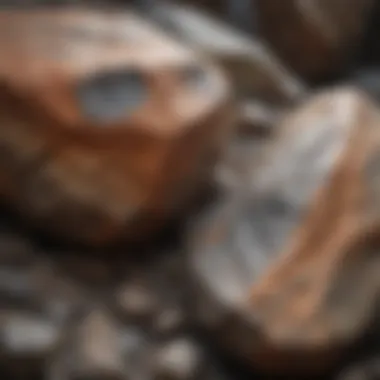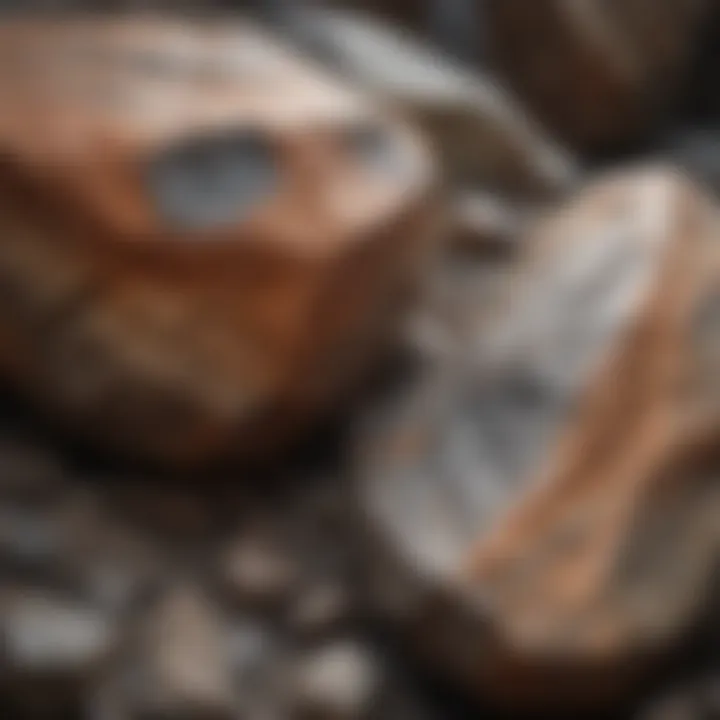Comprehensive Insights into Types of Rocks


Intro
Delving into the realm of geology, the different types of rocks serve as the building blocks of our planet, each possessing unique traits and formations. Understanding these varieties—igneous, sedimentary, and metamorphic—offers valuable insights into Earth's rich history and processes. For those fascinated by the natural world, knowledge of these rock types is akin to possessing a treasure map, leading to discoveries both in nature and in the practical applications of these materials.
These rocks arise from diverse scenarios: igneous rocks emerge from cooling magma or lava, sedimentary rocks form from the compaction and cementation of sediments, and metamorphic rocks transform under conditions of high pressure and temperature. This article aims to illuminate these distinctions and reveal the intricate processes at work behind them. Let's embark on this journey, exploring their formation, characteristics, and relevance.
Featured Collectible of the Month
Overview
This month, we turn our attention to a unique collectible that embodies the diverse landscape of geology: the Amethyst Geode. Renowned for its striking violet hues and crystalline structures, the Amethyst Geode not only captures the eye but also offers rich geological stories.
Historical Significance
Amethyst has a deep-rooted history, linked to ancient civilizations. The Greeks believed it could ward off intoxication, while the Egyptians used it in jewelry as a symbol of protection. Its lore ties back to the use of this stone in royal regalia, indicating status and power. Today, collectors and hobbyists alike cherish Amethyst for its aesthetic beauty and believed metaphysical properties, making it a staple in mineral collections.
Identification Techniques
Visual Characteristics
Identifying different types of rocks, especially when examining collectibles, requires keen observation. Here are some key aspects to consider:
- Color: Igneous rocks can exhibit a range of colors depending on their mineral content. For instance, basalt usually appears dark, while granite showcases lighter hues.
- Texture: The texture can hint at the method of formation. For instance, sedimentary rocks often feel gritty due to their layered compositions, while metamorphic rocks like schist show distinct banding or foliation.
- Crystal Formation: Look for visible crystals; larger crystals suggest slow cooling in igneous rocks, whereas small, tightly packed crystals may indicate rapid cooling.
Resources for Identification
To streamline your rock identification journey, consider utilizing these resources:
- Wikipedia: Geology offers foundational insights into rock types and their formation processes.
- Britannica: For deeper historical and practical context regarding rocks, Encyclopedia Britannica serves as an excellent reference.
- Online communities such as Reddit can provide invaluable advice and insights from fellow enthusiasts.
- For visual inspiration and updates on collectibles, Facebook hosts numerous groups focused on rocks and minerals.
Taken together, these aspects not only lay the groundwork for understanding rock classification but also enhance the appreciation for the natural world around us.
"The more we explore the characteristics of rocks, the more we unveil the stories they tell about our planet's history."
With this foundation, we are well on our way to comprehensively grasping the fascinating world of rocks, as we illuminate their importance within both academic and commercial spheres.
Intro to Rocks
Rocks form the bedrock of our planet's geology, playing a crucial role not just in the Earth's crust, but also in the larger ecosystem. Understanding rocks is akin to grasping the very foundation of our world, from landscapes to natural resources. This article seeks to shed light on the intricate tapestry of rock types—igneous, sedimentary, and metamorphic—across their formation processes, characteristics, and significance.
Grasping the concept of rocks is fundamental for rock and fossil collectors, geologists, students, and any nature enthusiast. It provides a language through which we can name and categorize the materials that shape our environment. Learners benefit by connecting their observation of rocks to broader geological principles. Understanding the types of rocks allows collectors to identify, appreciate, and value their finds.
Defining Rocks
Rocks are naturally occurring solid aggregates of one or more minerals, mineraloids, or organic materials. Picture a rock as a complex puzzle, made up of various pieces—each mineral contributing its color, texture, and hardness. The presence of these minerals determines the rock's physical and chemical properties, making each specimen unique. Generally, geologists recognize three primary rock classes:
- Igneous Rocks: Formed from cooling and solidification of magma or lava.
- Sedimentary Rocks: Created through the accumulation and compaction of mineral and organic particles.
- Metamorphic Rocks: Resulting from the alteration of existing rock due to heat, pressure, and chemical processes.
This classification is not just for academic purposes. It serves as a framework to understand the origin and evolution of the materials that constitute our planet.
The Role of Rocks in Earth’s Structure
Rocks play an indispensable role in shaping the structure of the Earth. They form the lithosphere, which includes the crust and the upper layer of the mantle. Through geological processes like plate tectonics, erosion, and sedimentation, rocks interact dynamically with one another, shaping mountains, valleys and even influencing natural disasters.
Each type of rock contributes to the Earth in different ways:
- Igneous Rocks: They form the basis of the continent's crust after cooling from molten magma. Their mineral compositions can host valuable resources like metals and gemstones.
- Sedimentary Rocks: Often found in layers, they contain fossils that give clues to past life on Earth, offering a rich history that reflects environmental changes over millions of years.
- Metamorphic Rocks: They provide insights into the conditions deep within Earth’s surface, revealing the pressure and temperature extremes that lead to their formation.
"Rocks are the silent storytellers of Earth's history, each layer and mineral holding tales of time itself."
In summary, the definition of rocks and their role in Earth's structure lays a robust groundwork for deeper exploration into the different types of rocks. Understanding these elements serves as a springboard for appreciating the complexities of geological sciences, as well as the practical applications of geology in various fields. Through this lens, we can begin to inflate our grasp of how tangible aspects of our world come about and evolve over time.
Classification of Rocks
Understanding the classification of rocks is crucial for anyone dipping their toes into geology. Not only does it help us make sense of the complex world beneath our feet, but it also unlocks a treasure trove of information about the Earth's history and the natural processes that shape it. Classifying rocks enables geologists and hobbyists alike to better identify, study, and utilize these natural formations.
Rocks can be broadly categorized into three main types: igneous, sedimentary, and metamorphic. Each category tells a unique story about its origin. Igneous rocks, for example, originate from molten magma, while sedimentary rocks form from particles accumulated over time. Meanwhile, metamorphic rocks arise from the alteration of existing rocks due to heat and pressure. This clear delineation simplifies the study of rocks and makes it easier for collectors to identify what they have.
Overview of Rock Types


Rocks are an essential part of the Earth’s crust, and they can be grouped based on their formation processes. Let's break down the three primary categories:
- Igneous Rocks - These originate from magma or lava. The cooling and solidification process can happen beneath the Earth’s surface (intrusive) or on its surface (extrusive). Common examples include granite and basalt.
- Sedimentary Rocks - Formed from the accumulation of sediments, these rocks often display layers. They can contain fossils, and examples include sandstone and limestone. These rocks are vital for understanding past environments.
- Metamorphic Rocks - These are transformed from existing rocks due to intense heat and pressure. They often exhibit unique textures and mineral compositions. Notable examples include schist and marble.
Each type of rock bears unique characteristics and significance that highlight the complex processes at play in our planet's geology.
Importance of Rock Classification
Classifying rocks isn’t just an academic exercise, but a vital part of understanding the Earth's past and present. Here are some key reasons why rock classification holds significance:
- Identifying Geological History: Each rock type offers insights into the environment under which it formed. For instance, the presence of fossilized remains in sedimentary rock can indicate historical biological activity.
- Practical Applications: Knowing the different rock types is essential for multiple industries including construction and mining. For example, granite is prized for countertops, while limestone is essential for cement.
- Study of Natural Resources: Classification helps in locating and managing natural resources. Understanding where specific rock types lie can lead to successful resource extraction.
"Rock classification not only affects industry and technology but also enhances our appreciation of nature’s artistry over millennia."
Igneous Rocks
Igneous rocks are fundamental to our understanding of geology. They not only provide insight into the Earth's history but also contribute significantly to numerous practical applications. The study of igneous rocks allows geologists to learn about volcanic activity, and the cooling process of magma. In essence, they serve as a window into the inner workings of our planet.
In the context of rock classifications, igneous rocks can reveal much about the environment in which they formed. Whether they are from a volcanic eruption or crystallized deep underground, they have distinct characteristics worth noting. Moreover, understanding these rocks is essential for hobbyists and collectors, who often seek out unique features and formations in their specimens.
Formation of Igneous Rocks
The formation of igneous rocks is a captivating process that begins deep within the Earth. It starts when magma, which is molten rock located beneath the surface, rises towards the Earth's crust. As it ascends, it undergoes cooling and solidification.
This cooling can occur in one of two primary environments:
- Intrusive: When the magma cools slowly beneath the surface, allowing large crystals to form.
- Extrusive: When magma erupts on the surface as lava. This lava cools rapidly, leading to smaller crystals.
As such, these environments play a crucial role in the texture and mineral composition of igneous rocks.
Types of Igneous Rocks
Intrusive Igneous Rocks
Intrusive igneous rocks, also known as plutonic rocks, form when magma cools slowly beneath the Earth's surface. One of their key characteristics is the presence of large, visible crystals, which arise from the extended cooling period. This slow solidification process allows minerals like quartz, feldspar, and mica to grow sizable and well-formed.
These rocks are often considered beneficial for both aesthetic and practical reasons. For collectors, the well-defined crystals provide breathtaking specimens that are sought after. Granite is a popular example and shows how beautiful these rocks can be. The downside is that intrusive rocks, being underground, are not found as abundantly on the surface, making collection more challenging.
Extrusive Igneous Rocks
Extrusive igneous rocks, or volcanic rocks, form from lava that erupts onto the Earth's surface and cools quickly. A notable characteristic of these rocks is their glassy texture and often fine-grained appearance due to the rapid cooling. They tend not to form visible crystals, which can be a consideration for collectors looking for specific formations.
An example of an extrusive igneous rock is basalt, commonly found in oceanic crust. It’s a favored rock for many because it’s readily accessible. However, the lack of visible crystals can be a drawback for collectors who appreciate distinct mineral features. Compiling a diverse collection often requires a mix of both intrusive and extrusive finds.
Examples of Common Igneous Rocks
The world is rich with igneous rocks, and several stand out among them. Some commonly encountered examples include:
- Granite: A coarse-grained intrusive rock, often used in construction and decorative stonework.
- Basalt: A fine-grained extrusive rock that forms large landforms like plateaus.
- Pumice: A light, porous volcanic rock characterized by its vesicles, often used in beauty products.
- Obsidian: A naturally occurring volcanic glass known for its smooth texture and sharp edges.
These rocks not only enhance geological studies but also have significant applications in construction, art, and everyday materials.
Sedimentary Rocks
Sedimentary rocks play a pivotal role in understanding not just geology, but the entire narrative of Earth’s history. These rocks are formed through processes that involve the accumulation of sediments, which can be derived from pre-existing rocks, organic materials, or chemical precipitates. Their significance lies in their ability to preserve fossils, provide natural resources, and offer insight into past environments, making them essential to both scientific study and practical applications.
Formation Processes of Sedimentary Rocks
Sedimentary rocks form through a series of steps that can be grouped into three main processes: weathering, transportation, and deposition. First, weathering breaks down existing rocks through physical or chemical means, creating smaller particles or sediments. Once these sediments are produced, they are transported by wind, water, or ice. Eventually, they settle in a new location, often layered over time, leading to compaction and cementation. This consolidation transforms loose sediments into solid rock. Understanding these processes is crucial as they reflect the dynamic nature of Earth's surface and its constant changes.
Types of Sedimentary Rocks
Sedimentary rocks can be categorized into three primary types, each with distinct characteristics and formation methods.
Clastic Sedimentary Rocks
Clastic sedimentary rocks are composed primarily of fragments derived from pre-existing rocks. They are classified based on the size of the sediment particles they contain, ranging from fine mud to coarse gravel. When it comes to popular choices in studying geological history or collecting, these rocks are often favored because they can preserve a wealth of information about ancient environments.
A key characteristic of clastic rocks is their stratification, or layering, which provides insights into past geological events. For example, sandstone is a common clastic rock that forms from the compaction of sand grains. One unique feature of clastic sedimentary rocks is their ability to contain fossils, thus offering a glimpse into life forms that once existed. However, collectors should be mindful that not all areas yield equally fascinating specimens; some sites may be more fruitful than others based on geological history.
Biochemical Sedimentary Rocks


Biochemical sedimentary rocks are interesting in that they form from biological processes, often involving the remains of living organisms. A prime example is limestone, which can consist of accumulated shells or coral fragments. These rocks are essential for understanding the impact of life on Earth’s history.
Their key characteristic is the organic matter within them, which can provide rich insights into past ecosystems. Also, biochemical rocks are often desirable due to their aesthetic value in landscape and architecture. Still, they might be less abundant compared to other types, posing a challenge for collectors seeking variety.
Chemical Sedimentary Rocks
Chemical sedimentary rocks, formed when minerals precipitate from solution, reveal much about the chemical makeup of ancient waters. A well-known example is rock salt, which forms from the evaporation of saline water.
Their defining feature is their chemical composition, which can tell a story about the environment from whence they came. For example, these rocks are often found in desert basins or shallow seas where conditions lead to evaporation. The advantage of chemical sedimentary rocks lies in their potential for economic resources, such as salts and certain minerals. However, collectors may find them less visually appealing compared to their clastic counterparts.
Importance of Sedimentary Rocks
The importance of sedimentary rocks cannot be overstated. Not only do they chronicle the Earth's history through the layers they contain, but they also serve functional purposes in modern society.
For instance, many sedimentary rocks serve as reservoirs for groundwater, making them crucial to agriculture and drinking water supply. Additionally, they house valuable resources, including coal, oil, and natural gas, which are instrumental in energy production.
In summary, sedimentary rocks are like a long, detailed letter from the past, revealing information about life, climate, and geology over time, serving both educational and practical purposes.
Metamorphic Rocks
Metamorphic rocks play a crucial role in understanding the dynamic processes that shape the Earth’s crust. They are the result of existing rocks undergoing transformation due to intense heat, pressure, and chemically active fluids. This metamorphic process not only alters the minerals present but also changes the texture and structure of the rock, providing key insights into geological history. Exploring metamorphic rocks is essential for hobbyists and professionals alike, as they serve as a bridge between igneous and sedimentary classifications and reveal the complex interactions within Earth's crust.
Understanding Metamorphism
Metamorphism refers to the process whereby a rock's original mineral composition is transformed under extreme conditions. This change can occur in various environments, whether in deeper crustal settings or near tectonic plates. The study of metamorphism helps geologists understand the forces that alter rock, which ultimately aids in predicting geological features.
One significant concept associated with metamorphism is the role of temperature and pressure. Depending on these factors, rocks can change differently. For instance, the metamorphosis of shale into schist occurs under relatively moderate conditions, while granite might transform into gneiss only under extreme conditions. Recognizing the metamorphic grade, or the intensity of pressure and temperature that a rock has undergone, becomes crucial for determining its properties and historical significance.
Types of Metamorphic Rocks
Metamorphic rocks are broadly categorized into two types based on their texture: foliated and non-foliated rocks.
Foliated Metamorphic Rocks
Foliated metamorphic rocks exhibit a distinct layering or banding due to the directional alignment of mineral grains. Schist and gneiss are prime examples of this type. The key characteristic of foliated rocks is their layered appearance, resulting from the parallel arrangement of minerals like mica or graphite, which allows them to split along these planes easily.
The unique feature of foliated metamorphic rocks is their ability to reflect the conditions under which they formed. For rock and fossil collectors, foliated rocks are particularly appealing because of their aesthetic qualities and the information they provide about geological history. However, while they can be visually striking, the planes along which they cleave may make them less suitable for certain construction purposes.
Non-Foliated Metamorphic Rocks
On the other hand, non-foliated metamorphic rocks do not show any banding or layering. They are typically formed in situations where pressure is applied uniformly, rather than from one direction. Marble and quartzite represent the non-foliated group.
The key characteristic of non-foliated rocks is their homogenous appearance. They tend to be composed of a single mineral type, which leads to a more uniform structure. The unique feature of non-foliated metamorphic rocks makes them a popular choice for collectors, particularly in decorative uses like countertops or sculptures. Their lack of fissility lends them strength, making them suitable for various construction applications. However, this uniformity may also mean fewer clues about their metamorphic history compared to their foliated counterparts.
Applications of Metamorphic Rocks
Metamorphic rocks have a wide range of applications due to their diverse physical and chemical properties. In construction, rocks like marble and slate are prized for their durability and aesthetic appeal. Marble is often used in sculpture and architecture, while slate is popular for roofing and flooring.
In industry, these rocks have commercial uses as well. Such applications include their use as aggregates or in manufacturing silica and other mineral products. Moreover, some metamorphic rocks are mined for their mineral content, contributing to various manufacturing processes.
Metamorphic rocks also hold cultural significance, often being incorporated into art and architecture, serving as reminders of our planet's tumultuous yet beautiful geological history.
The study of metamorphic rocks not only enriches our understanding of Earth's processes but also enhances our appreciation for the materials that shape our built environment.
The Rock Cycle
Understanding the rock cycle is crucial for grasping the dynamic processes that govern how rocks transform from one type to another. This cyclical journey among igneous, sedimentary, and metamorphic rocks illustrates the interconnectedness of geological formations over vast periods. Learning about the rock cycle not only enhances one’s knowledge of geology but also fosters a deep appreciation for the Earth’s natural history and diversity.
Understanding the Rock Cycle
The rock cycle is a fundamental concept in geology, describing the continuous process of rock formation, degradation, and transformation. It is not a linear progression but a complex web of interactions involving different processes. For instance, igneous rocks can be broken down into sediments through weathering and erosion, which can later compact and cement into sedimentary rocks. Meanwhile, sedimentary rocks subjected to heat and pressure may metamorphose into metamorphic rocks.
Here are some essential points to highlight the cycle’s complexity:
- Weathering: This is the process where rocks are broken down into smaller pieces by natural forces like wind, water, and temperature changes.
- Erosion: Once broken, these particles are transported by water, wind, or ice, leading to the displacement of sediments.
- Compaction and Cementation: Over time, accumulated sediments can become compacted, forming sedimentary rocks, often layered and rich in history.
- Metamorphism: This transformation occurs deep within the Earth where intense heat and pressure morph sedimentary or igneous rocks into metamorphic varieties.
- Melting: At even higher temperatures, rocks may melt, returning to a molten state, forging the path back to igneous rock formation when cooled.
"The rock cycle is a testament to Earth’s resilience, demonstrating how nothing is ever truly lost but transformed through time."
The Interconnectivity of Rock Types
The beautiful thing about the rock cycle is how it illustrates the interconnectedness of these various rock types. Not only do rocks transition from one form to another; they also interact with one another in complex ways throughout geological time. This interrelationship emphasizes the importance of understanding each rock type’s characteristics, formation processes, and the environmental conditions influencing their transitions.
Key points regarding rock interconnectivity include:
- Ecosystems: Each rock type plays a vital role in supporting different ecosystems. For example, limestone, a sedimentary rock, can host unique habitats for various organisms.
- Soil Formation: The breakdown of rocks significantly contributes to soil composition, which is crucial for plant life.
- Resource Recycling: The cycle highlights natural resource recycling. Many minerals found in sedimentary rocks originate from the breakdown of igneous rocks above them.
- Cultural Significance: Different rock types have impacted human history, from construction materials to tools, shaping cultures and civilizations.


Through a thorough understanding of the rock cycle, rock and fossil collectors can garner a deeper insight into the materials they collect, perhaps discovering the journey behind each piece they treasure. This awareness ultimately enriches the collecting experience, revealing intricate stories locked within the formations of the Earth.
Practical Applications of Rocks
Understanding the practical applications of rocks enriches our appreciation for their role not just in nature, but also in human civilization. Rocks serve as a foundation for various industries, crafts, and even cultural expressions. This section will shed light on the multifaceted ways rocks integrate into our lives, emphasizing their importance in construction, industrial practices, and the arts.
Uses in Construction and Industry
Rocks are the backbone of construction and industry, serving as essential raw materials. From towering skyscrapers to sprawling roads, the choice of rock types affects durability, aesthetics, and environmental impact. The most commonly utilized rocks in construction include granite, limestone, and sandstone. Each offers unique properties that make them valuable in specific applications.
- Granite: Known for its strength and resilience, granite is often favored for countertops and flooring because it can withstand wear and tear. Additionally, it's frequently used in monumental architecture, such as cathedrals and sculptures, due to its aesthetic appeal.
- Limestone: This rock is essential in the production of cement, making it a crucial element in building infrastructure. Its softer texture makes it easier to cut and shape, which contributes to its high utility as both a building material and for decorative purposes in gardens.
- Sandstone: Renowned for its versatility, sandstone's colors and textures enhance both building interiors and exteriors. In many regions, historical buildings are crafted from local sandstone, exemplifying cultural heritage.
Not only do these rocks serve structural purposes, but they are also employed in landscaping, where they create visually pleasing environments. Furthermore, industries utilize crushed rocks for aggregate in road construction and as ballast for railways, proving their indispensable role across various sectors.
"Rocks are the silent witnesses to humanity's ambitions, shaping our landscapes and living spaces for centuries."
Rocks in Art and Culture
The artistic utilization of rocks transcends generations, providing a canvas for creativity and expression. Artists and cultural practitioners leverage the natural beauty and textures of rocks to produce stunning works, whether in sculpture, architecture, or jewelry making.
- Sculpture: Many well-known sculptures, such as Michelangelo’s David, are carved from marble, a metamorphic rock that demonstrates remarkable polish and durability. Sculptors have long harnessed the qualities of various stones to explore themes and cultural narratives.
- Architecture: Historical buildings, cathedrals, and monuments frequently utilize local rock types, preserving their cultural significance. The intricate designs often tell stories that reflect the heritage and values of the societies that built them.
- Jewelry: Precious and semi-precious stones, like diamonds, emeralds, and turquoise, are not just valued for beauty but also for their historical and cultural importance in various societies. These materials evoke emotions and signify status, love, and tradition.
Rocks also appear in folklore and mythology, where they become symbols of strength, stability, or even protection. In every phase of human life—from birth to ceremony—stones often carry meanings that enrich our cultural landscapes.
In sum, rocks extend beyond their geological framework, inviting enthusiasts to explore their historical, functional, and aesthetic significance in our lives.
Collecting Rocks
Collecting rocks is not just a hobby; it’s a gateway to understanding the Earth's history and discovering the natural beauty hidden along the surface. For enthusiasts, whether novice or seasoned, the thrill of finding a unique or rare specimen adds a sense of accomplishment that resonates deeply. The act of collecting transcends mere accumulation; it connects individuals with the very essence of nature and offers numerous benefits.
The practice of rock collecting enhances observational skills, fosters a love for geology, and helps in developing patience and persistence. Each time a collector steps outdoors, they expose themselves to diverse terrains and ecosystems, enriching their appreciation for nature. Furthermore, this hands-on exploration provides a chance to engage in a lifelong learning process, guiding individuals through the complexities of mineralogy, crystallography, and more broadly, geological sciences.
"A rock is the window through which we can discover the forces that have shaped our world."
Apart from learning, sharing discoveries with fellow collectors enriches the experience. Building a community around shared interests can lead to friendships and collaborative explorations, expanding not only one's collection but also one's understanding of geology.
How to Start Collecting Rocks
Beginning a rock collection is akin to embarking on an exciting adventure. The first step is to familiarize oneself with the different types of rocks and their characteristics. Understanding the basics of igneous, sedimentary, and metamorphic rocks lays a solid foundation. Not all rocks are created equal, and recognizing their differences can greatly enhance the collection journey.
A good starting point is to set clear objectives for your collection:
- Choose a Focus: Decide if you want to collect specific types, like gemstones or fossils, or perhaps focus on regions, like local geology.
- Research Locations: Find out where to collect—national parks, riverbeds, or specific mountains often yield a variety of specimens.
- Plan Field Trips: Take the time to explore different environments. Bring a guidebook to help with identification and increase the chance of discovering interesting finds.
A simple collection can begin with common rocks found in your backyard or local parks. Often, the most mundane spots may surprise you with their offerings. Keeping records of your finds can be incredibly rewarding, allowing you to track personal discoveries and learn more about each piece.
Tools and Resources for Collectors
Equipping yourself with the right tools is crucial for a fruitful collecting experience. Here’s a list of essentials that every rock collector should consider:
- Field Guidebooks: Reference books on rocks and minerals are invaluable for identification. Guides specific to your area's geology help narrow down what to find.
- Hand Tools: Carry a hammer, chisel, or rock pick for more stubborn specimens. A handheld magnifier can reveal details that the naked eye misses.
- Safety Gear: Always wear sturdy shoes and gloves to protect yourself when searching in rugged areas. Safety goggles can prevent eye injuries while breaking rocks.
- Storage Solutions: As your collection grows, invest in storage boxes or display cases. Keeping specimens organized and safe will help you maintain their quality and integrity.
In addition to physical tools, a wealth of resources is available online. Websites like Reddit and Facebook offer communities where collectors share insights and advice. Educational resources from Wikipedia and Britannica present foundational knowledge to deepen your understanding. Various forums cater specifically to geology and rock collecting, providing platforms for questions and exchanges.
Lastly, consider joining local rock clubs or organizations. Not only will these provide valuable information, but they also often organize field trips, workshops, and events that enhance the overall collecting experience.
Finale
In wrapping up our discussion on the nuances of rock types, it's essential to reflect on the diverse attributes and significance of these natural formations. Each category of rock—igneous, sedimentary, and metamorphic—has its unique characteristics, formed through various processes that tell a story of the Earth's dynamic history. This section acts as a platform to emphasize why understanding these rocks is not merely an academic exercise but a gateway to appreciating the intricate tapestry of our planet.
Reflecting on Rock Types
When we talk about rock types, we are, in essence, examining the very fabric of Earth. From the fiery depths that give birth to igneous rocks to the layered sedimentation characteristic of sedimentary formations, each type serves a specific purpose—both in nature and human society. Igneous rocks, like granite and basalt, resonate with strength and resilience, while sedimentary rocks, such as sandstone and limestone, showcase the whimsical artistry of nature’s processes. Metamorphic rocks, including schist and marble, underline the transformative power of heat and pressure.
By recognizing the properties and formation processes of these rock types, collectors and hobbyists can make informed choices when expanding their collections. Understanding where to find these rocks, what environmental factors affect their existence, and their historical significance all adds layers of depth to the collecting experience.
"Rocks are the Earth’s history books, their layers tell stories of ancient environments and evolutionary changes."
Encouraging Further Exploration
Exploring the world of rocks is an ongoing journey. To foster a continued interest, collectors and enthusiasts should consider venturing beyond surface-level knowledge. Attending geology workshops, joining local rock clubs, and participating in field trips can greatly enhance one’s appreciation and understanding of various rock types. Moreover, engaging with online communities provides additional perspectives and shared experiences that enrich personal knowledge.
For those new to the hobby or seasoned collectors alike, here are a few suggestions to encourage further exploration:
- Visit National Parks: Many parks have unique rock formations and geological features well worth studying.
- Join Clubs: Rock and mineral clubs often conduct meetings, field trips, and educational sessions for all levels of interest.
- Utilize Online Resources: Websites like wikipedia.com and britannica.com provide valuable information to deepen your studies.
- Connect on Social Media: Platforms like reddit.com and facebook.com have groups dedicated to rock collecting where members share findings, tips, and insights.
By remaining curious and committed to continuing education about rocks, you will not only enhance your personal collection but also contribute positively to the community of collectors and geologists. Rocks, after all, are not just objects—they are treasures waiting to be discovered and understood.



